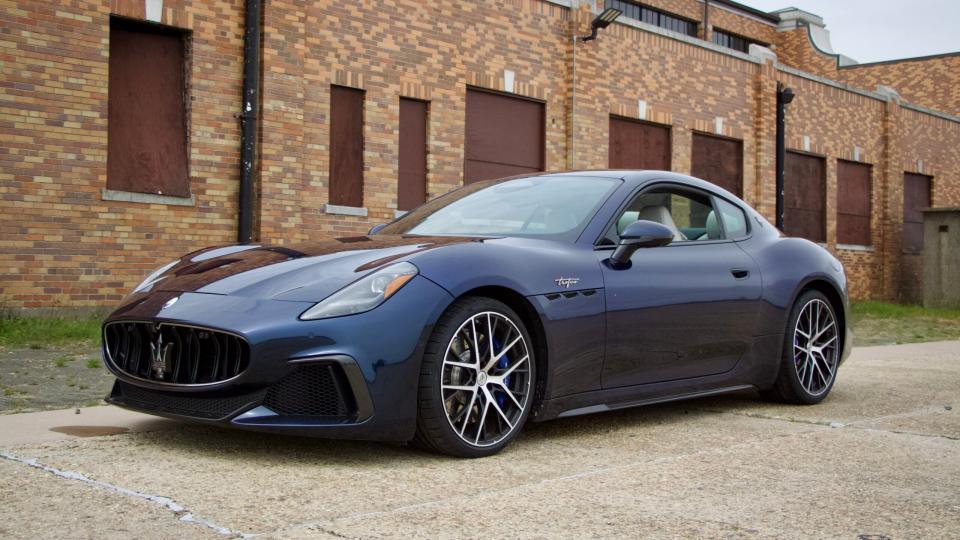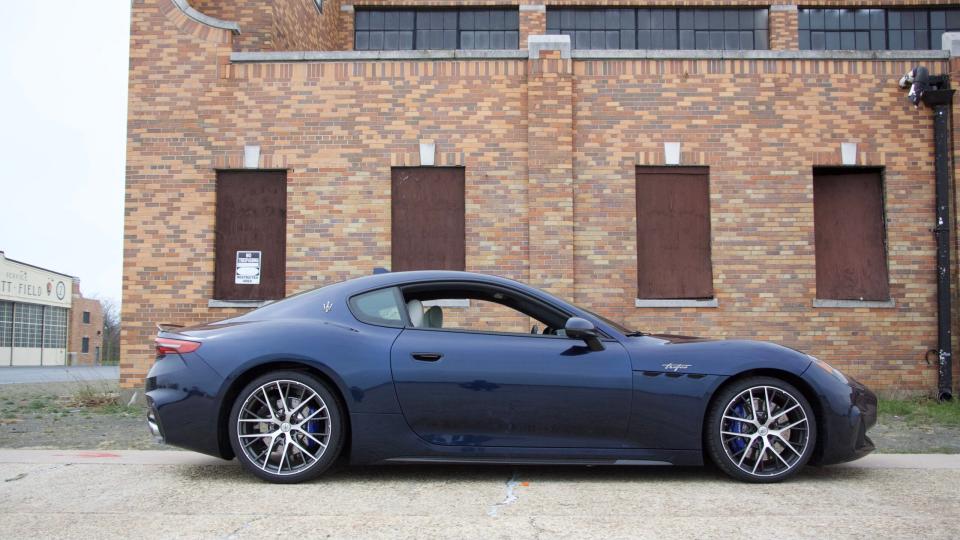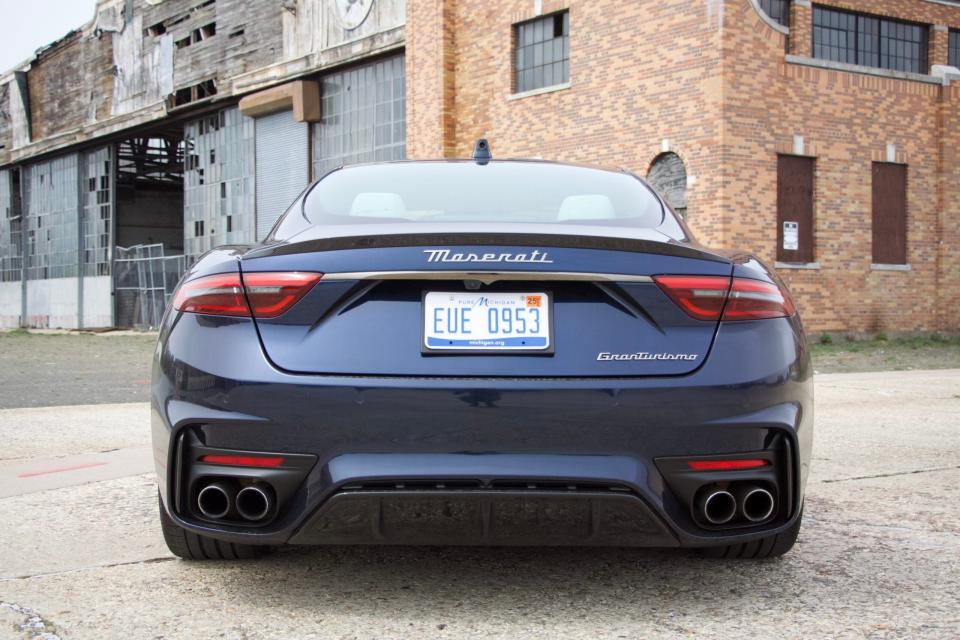2024 Maserati Gran Turismo Review: Delightful Drive, Questionable Buy

The rational mind is a bummer. Mine reminds me of things like, “Ice cream is not a reasonable breakfast,” and “F1 driver is not a realistic career choice.” And, occasionally: “The 2024 Maserati Gran Turismo is a nice car, but $220,000?”
Bummer, right—that logic won’t let me enjoy a DQ Blizzard before noon or tell you that Maserati’s four-seat sports car is a good value at nearly a quarter-million dollars. We know Maseratis hold their value about as well as colanders hold water, which means first owners will spend a fortune to own one of these.


That’s a shame, because look at it. The Gran Turismo is one of the most emotional and delightful new cars I’ve driven, blurring the line between grand tourer and full-on sports car in a way few can. I could drive one of these every day and feel like a king, even if I’d have to start out as an oligarch to afford the inevitable depreciation.
The Basics
For the first time since 2008, the Maserati Gran Turismo enters an all-new generation. (Your move, R35 GT-R.) It looks familiar but fresh: aluminum, magnesium, and carbon fiber draped over recognizable curves. Underneath the elegant exterior is the Giorgio Sport platform, a lengthened version of the Alfa Romeo Giulia and Stelvio’s balanced chassis.
There are two powertrain options: in Modena and Trofeo trims, a 542-horsepower, 3.0-liter twin-turbocharged Nettuno V6 borrowed from the MC20 supercar paired to an eight-speed automatic while the electric Folgore model uses two electric motors to make 751 total hp. All Gran Turismos, regardless of powertrain choice, have rear-biased all-wheel drive. This review will focus on the gas-burning Trofeo model since that’s what I drove, but my colleague Nico DeMattia sampled the Folgore on track and had high praise for it.

Maserati’s Nettuno engine is a close relative of Ferrari’s F154 V8 and Alfa’s 2.9-liter twin-turbo V6, but what makes it unique is its passive pre-chamber ignition tech. By adding a spark plug in each cylinder’s pre-chamber, Maserati claims to make combustion faster and more efficient, increasing the engine’s compression ratio by 15%. As far as I know, this is the only production car engine that does this, and if you want a deep dive, Engineering Explained has you covered. CliffsNotes, said through pinched fingers and a glass of red wine: More faster explosion, more power.
Driving the Maserati Gran Turismo
The first thing I noticed about the Gran Turismo was its steering. It’s razor-sharp, with a quick ratio and light weight familiar to anyone stepping out of a Giulia Quadrifoglio or even a Ferrari. This gives the two-ton coupe a feeling of precision and placeability that you don’t get in, say, a modern BMW M car.

Next: The engine. If anyone tells you turbocharged V6s lack character, point them to this one. While not as sonorous as the F136 V8s of the past, the Nettuno V6 is alive with pops, whizzbangs, and snorts on its way to a 6,500-rpm power peak. Peak torque (479 lb-ft) arrives at 3,000 rpm, which means glorious midrange romps. Letting off the throttle leads to wastegate flutter and overrun crackles. It feels like a supercar engine in a grand tourer because, well, it is—and that makes it charming. What’s more, I saw nearly 26 mpg while behaving myself on a highway trip.
On top of the Gran Turismo’s athletic underpinnings and all-wheel drive, those two elements make for a car that annihilates back roads. The Maserati turns in like a much smaller, lighter car and the front end has plenty of mechanical grip. Thanks to the all-wheel drive and electronic diffs, you can get on the power early, and the Gran Turismo claws itself out of corners without drama. There’s little body roll and the car gets better the more you push it—though I was nowhere near its limits on public roads.
True to its GT name, Maserati’s adaptive air suspension that keeps it flat in corners also makes it a supple highway ride. Switching the drive mode from Sport to GT relaxes the throttle and steering to make things comfortable, but if you step on it to make a quick pass, the transmission still responds with a quick double- or triple-downshift.


If there’s anywhere the car falls on its face, it’s around town. Even in Comfort mode, there’s not much suspension travel, and a low front end with a carbon-fiber splitter means you’re inspecting driveway aprons on Google Maps as pre-trip planning. I’m not sure when we decided as a culture that sports cars needed 21-inch wheels, but I tiptoed in and out of the city terrified of bending one or shredding a low-profile Pirelli.
Finally, the large rotors and brake-by-wire system that are unfazed in the mountains make smooth stops difficult in stop-and-go driving. I’m glad Maserati favored sporty driving and high-speed cruising over block-to-block creeping in its calibration. Still, as many of these are destined to putt around Beverly Hills, the Hamptons, or West Palm Beach, it’s relevant to mention.
The Highs and Lows
Up to now, I’ve talked a lot about the Gran Turismo’s positives. It looks, sounds, and feels exotic; it’s dynamically excellent yet civil enough to live with (almost) every day.
Now, on to the negatives. Although the seats, leather interior trim, digital center clock, and aluminum shift paddles are very nice, the new console is not. The center stack has been taken over by two touchscreens, the bottom of which angles upward at about 30 degrees and reflects every ray of sunshine that enters the car. Good thing that screen is the only way to adjust HVAC. Oh, and the four piano-black plastic buttons above it for gear selection? Tacky, cheap-feeling, and almost reminiscent of those in a Fiat 500e.



There are other cheap, synthetic surfaces around the interior. The inside of the interior door pull, for example, a piece no one sees but is felt every time you get in the car feels like the bottom of a mousepad. This would be borderline unacceptable in an $80,000 Alfa Romeo; in a $200,000 Maserati, it’s blasphemous.
Maserati Gran Turismo Features, Options, and Competition
The base model (if you can call it that) Gran Turismo Modena starts at $159,995 including destination. That gets you the Nettuno engine in detuned, 483-hp, 361 lb-ft guise. Stepping up to the 542-hp, 480 lb-ft Trofeo costs $191,995, and that’s just getting started. Once you add $4,500 blue paint, a $4,000 Sonus Faber hi-fi sound system, the $2,500 carbon fiber rear spoiler, $700 worth of stitched tridents in the headrests, and an $8,300 ADAS package, you’re looking at $220K.
It’s a Maserati, so there are the customization options you’d expect: several dyed leather hues and bold exterior colors, wheel options, and contrast stitching. Then, there are the ones you don’t: The clock turns into a g-meter and a throttle position indicator, both of which you can use to scare your passengers. The head unit runs a reskinned version of Stellantis’ Uconnect 5, which is pleasant, and the digital instrument cluster changes its gauges based on drive mode, showing useful technical data like boost pressure and oil temperature in Sport and Corsa.




It’s tough to name direct competitors because, well, there aren’t that many four-seat GT cars anymore. Bentley’s Continental GT V8 S comes to mind, as does BMW’s M8 Competition. The heavier Bentley is far ahead in craftsmanship and is backed by VW Group tech including a variant of Porsche’s PDK dual-clutch transmission while the BMW starts $60,000 cheaper than the Gran Turismo. Broadening the search to two-seaters yields the hot new Mercedes-AMG GT and Aston Martin Vantage as well as the perennial rich-guy favorite Porsche 911 Turbo—all of which are priced within a hair of the Maserati while being appreciably more powerful. Yeah, we’re playing with the big boys here.
Value and Verdict
But the Gran Turismo’s biggest challenge might come from within Maserati’s parent company. For around $80,000, you can buy an Alfa Romeo Giulia Quadrifoglio, which rides on the same basic chassis as the Maserati, runs a very similar powertrain (albeit without the pre-chamber ignition heads), weighs 300 pounds less, and has two extra doors plus a back seat fit for adults. It’s both high praise for the Alfa and an indictment of the Maserati that, for nearly three times the price, the Gran Turismo just doesn’t differentiate itself enough.

I came away wondering who exactly the Gran Turismo is for. It’s hard to imagine enthusiasts picking it over the Aston or the Porsche, and folks looking for ultimate luxury will find it in the Bentley. Anyone looking for value will almost certainly go for the $60,000-cheaper BMW.
At $120,000 or even $160,000, I could say to hell with it and recommend this car on its emotional appeal and driving dynamics alone. But, for $220,000? My bummer of a left brain just won’t allow it.
2024 Maserati Gran Turismo Trofeo Specs | |
|---|---|





 Yahoo Autos
Yahoo Autos 